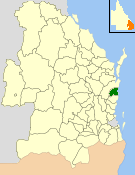Noosa Shire
| Shire of Noosa | |||||||
|---|---|---|---|---|---|---|---|
|
|||||||
|
|||||||
|
|||||||

|
|||||||
Noosa Shire ( Shire of Noosa ) was a Local Government Area about 130 km north of Brisbane in the Sunshine Coast region in Queensland . The county covered 868.7 square kilometers and existed as a local administrative area from 1910 to 2008 when it was merged with the Maroochy Shire and the city of Caloundra to form the new Sunshine Coast Regional Council .
history
The region was originally home to various Aboriginal tribes. These were mainly the Undumbi tribe in the south, the Dulingbara tribe in the north and the Gabbi Gabbi in the west.
Although the first reports about the region can already be found in the documents for Captain Cook's voyages of discovery in 1770, settlement did not begin until almost 100 years later. The first settlement was driven by the timber industry , followed by gold discoveries and a gold rush in the Gympie region, north of Noosa. The complicated transport of goods to and from the region was a particular problem that slowed development for a long time.
In 1871 a port was built in Tewantin. By 1877 two hotels, a school, a police station and a telegraph station were built.
Over the past 50 years, Noosa has grown from an isolated village that thrives on fishing into a popular tourist destination. Nevertheless, the region is still known today for its careful treatment of nature. There are no tall buildings and a lot of jungle. 34.8% of the region is protected as National Parks , Conservation Parks, State Forests or otherwise.
Administrative structure
The administration was led by an elected mayor and 9 council members.
cities and communes
Noosa:
Coastal region:
- Boreen Point
- Cooroibah
- Great Sandy National Park
- Marcus Beach
- Noosa National Park
- North Shore
- Peregian Beach *
- Teewah
Backland:
population
| year | population |
|---|---|
| 1933 | 5.768 |
| 1947 | 5.925 |
| 1954 | 6.296 |
| 1961 | 6.117 |
| 1966 | 6.673 |
| 1971 | 7.746 |
| 1976 | 10.825 |
| 1981 | 17.071 |
| 1986 | 20,328 |
| 1991 | 29.378 |
| 1996 | 41.171 |
| 2001 | 47,321 |
| 2006 | 51.962 |